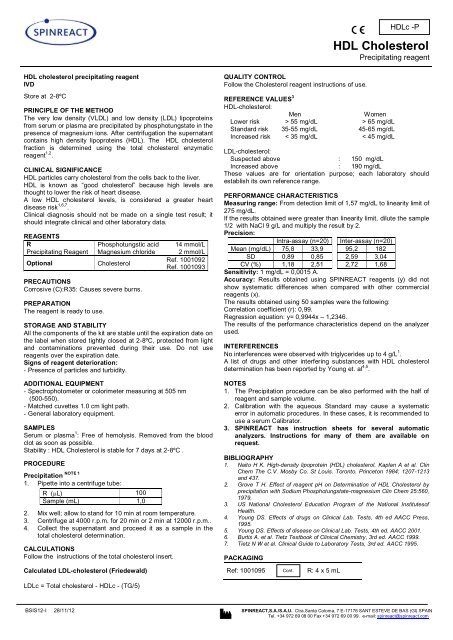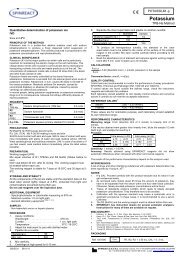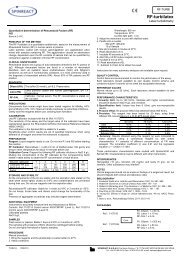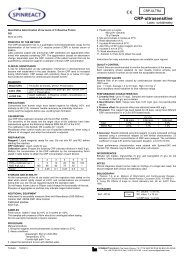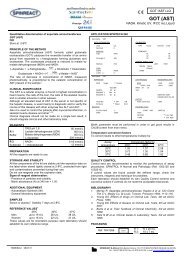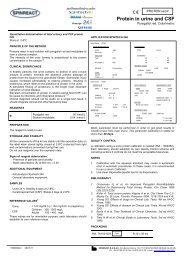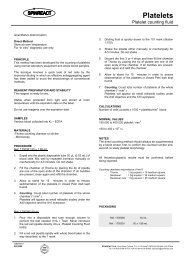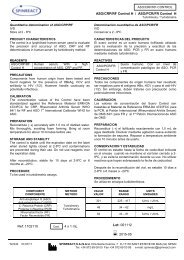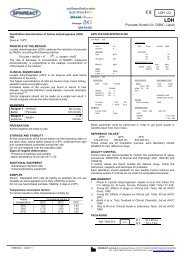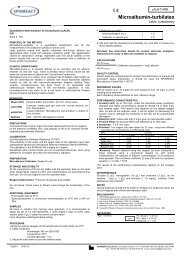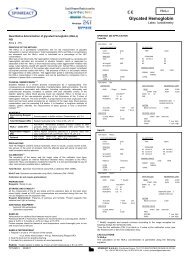HDL Cholesterol - Spinreact
HDL Cholesterol - Spinreact
HDL Cholesterol - Spinreact
You also want an ePaper? Increase the reach of your titles
YUMPU automatically turns print PDFs into web optimized ePapers that Google loves.
<strong>HDL</strong> cholesterol precipitating reagent<br />
IVD<br />
Store at 2-8ºC<br />
PRINCIPLE OF THE METHOD<br />
The very low density (VLDL) and low density (LDL) lipoproteins<br />
from serum or plasma are precipitated by phosphotungstate in the<br />
presence of magnesium ions. After centrifugation the supernatant<br />
contains high density lipoproteins (<strong>HDL</strong>). The <strong>HDL</strong> cholesterol<br />
fraction is determined using the total cholesterol enzymatic<br />
reagent 1,2 .<br />
CLINICAL SIGNIFICANCE<br />
<strong>HDL</strong> particles carry cholesterol from the cells back to the liver.<br />
<strong>HDL</strong> is known as “good cholesterol” because high levels are<br />
thought to lower the risk of heart disease.<br />
A low <strong>HDL</strong> cholesterol levels, is considered a greater heart<br />
disease risk 1,6,7 .<br />
Clinical diagnosis should not be made on a single test result; it<br />
should integrate clinical and other laboratory data.<br />
REAGENTS<br />
R<br />
Precipitating Reagent<br />
Phosphotungstic acid<br />
Magnesium chloride<br />
Optional <strong>Cholesterol</strong><br />
PRECAUTIONS<br />
Corrosive (C):R35: Causes severe burns.<br />
PREPARATION<br />
The reagent is ready to use.<br />
14 mmol/L<br />
2 mmol/L<br />
Ref. 1001092<br />
Ref. 1001093<br />
STORAGE AND STABILITY<br />
All the components of the kit are stable until the expiration date on<br />
the label when stored tightly closed at 2-8ºC, protected from light<br />
and contaminations prevented during their use. Do not use<br />
reagents over the expiration date.<br />
Signs of reagent deterioration:<br />
- Presence of particles and turbidity.<br />
ADDITIONAL EQUIPMENT<br />
- Spectrophotometer or colorimeter measuring at 505 nm<br />
(500-550).<br />
- Matched cuvettes 1.0 cm light path.<br />
- General laboratory equipment.<br />
SAMPLES<br />
Serum or plasma 1 : Free of hemolysis. Removed from the blood<br />
clot as soon as possible.<br />
Stability : <strong>HDL</strong> <strong>Cholesterol</strong> is stable for 7 days at 2-8ºC .<br />
PROCEDURE<br />
NOTE 1<br />
Precipitation<br />
1. Pipette into a centrifuge tube:<br />
R ( L) 100<br />
Sample (mL) 1,0<br />
2. Mix well; allow to stand for 10 min at room temperature.<br />
3. Centrifuge at 4000 r.p.m. for 20 min or 2 min at 12000 r.p.m..<br />
4. Collect the supernatant and proceed it as a sample in the<br />
total cholesterol determination.<br />
CALCULATIONS<br />
Follow the instructions of the total cholesterol insert.<br />
Calculated LDL-cholesterol (Friedewald)<br />
LDLc = Total cholesterol - <strong>HDL</strong>c - (TG/5)<br />
QUALITY CONTROL<br />
Follow the <strong>Cholesterol</strong> reagent instructions of use.<br />
<strong>HDL</strong>c -P<br />
<strong>HDL</strong> <strong>Cholesterol</strong><br />
Precipitating reagent<br />
REFERENCE VALUES 3<br />
<strong>HDL</strong>-cholesterol:<br />
Men Women<br />
Lower risk > 55 mg/dL > 65 mg/dL<br />
Standard risk 35-55 mg/dL 45-65 mg/dL<br />
Increased risk < 35 mg/dL < 45 mg/dL<br />
LDL-cholesterol:<br />
Suspected above : 150 mg/dL<br />
Increased above : 190 mg/dL<br />
These values are for orientation purpose; each laboratory should<br />
establish its own reference range.<br />
PERFORMANCE CHARACTERISTICS<br />
Measuring range: From detection limit of 1,57 mg/dL to linearity limit of<br />
275 mg/dL.<br />
If the results obtained were greater than linearity limit, dilute the sample<br />
1/2 with NaCl 9 g/L and multiply the result by 2.<br />
Precision:<br />
Intra-assay (n=20) Inter-assay (n=20)<br />
Mean (mg/dL) 75,8 33,9 95,2 182<br />
SD 0,89 0,85 2,59 3,04<br />
CV (%) 1,18 2,51 2,72 1,68<br />
Sensitivity: 1 mg/dL = 0,0015 A.<br />
Accuracy: Results obtained using SPINREACT reagents (y) did not<br />
show systematic differences when compared with other commercial<br />
reagents (x).<br />
The results obtained using 50 samples were the following:<br />
Correlation coefficient (r): 0,99.<br />
Regression equation: y= 0,9944x – 1,2346.<br />
The results of the performance characteristics depend on the analyzer<br />
used.<br />
INTERFERENCES<br />
No interferences were observed with triglycerides up to 4 g/L 1 .<br />
A list of drugs and other interfering substances with <strong>HDL</strong> cholesterol<br />
determination has been reported by Young et. al 4,5 .<br />
NOTES<br />
1. The Precipitation procedure can be also performed with the half of<br />
reagent and sample volume.<br />
2. Calibration with the aqueous Standard may cause a systematic<br />
error in automatic procedures. In these cases, it is recommended to<br />
use a serum Calibrator.<br />
3. SPINREACT has instruction sheets for several automatic<br />
analyzers. Instructions for many of them are available on<br />
request.<br />
BIBLIOGRAPHY<br />
1. Naito H K. High-density lipoprotein (<strong>HDL</strong>) cholesterol. Kaplan A et al. Clin<br />
Chem The C.V. Mosby Co. St Louis. Toronto. Princeton 1984; 1207-1213<br />
and 437.<br />
2. Grove T H. Effect of reagent pH on Determination of <strong>HDL</strong> <strong>Cholesterol</strong> by<br />
precipitation with Sodium Phosphotungstate-magnesium Clin Chem 25:560,<br />
1979.<br />
3. US National <strong>Cholesterol</strong> Education Program of the National Institutesof<br />
Health.<br />
4. Young DS. Effects of drugs on Clinical Lab. Tests, 4th ed AACC Press,<br />
1995.<br />
5. Young DS. Effects of disease on Clinical Lab. Tests, 4th ed. AACC 2001.<br />
6. Burtis A. et al. Tietz Textbook of Clinical Chemistry, 3rd ed. AACC 1999.<br />
7. Tietz N W et al. Clinical Guide to Laboratory Tests, 3rd ed. AACC 1995.<br />
PACKAGING<br />
Ref: 1001095 Cont.<br />
R: 4 x 5 mL<br />
BSIS12-I 28/11/12 SPINREACT,S.A./S.A.U. Ctra.Santa Coloma, 7 E-17176 SANT ESTEVE DE BAS (GI) SPAIN<br />
Tel. +34 972 69 08 00 Fax +34 972 69 00 99. e-mail: spinreact@spinreact.com
Reactivo precipitante de <strong>HDL</strong> colesterol<br />
IVD<br />
Conservar a 2-8ºC<br />
PRINCIPIO DEL MÉTODO<br />
Las lipoproteínas de muy baja densidad (VLDL) y baja densidad<br />
(LDL) del suero o plasma, se precipitan con fosfotungstato en<br />
presencia de iones magnesio. Tras la centrifugación, el<br />
sobrenadante contiene lipoproteínas de alta densidad (<strong>HDL</strong>). La<br />
fracción de <strong>HDL</strong> colesterol se determina utilizando el reactivo<br />
enzimático de colesterol total 1,2 .<br />
SIGNIFICADO CLÍNICO<br />
El colesterol transportado por las lipoproteínas de alta densidad<br />
(<strong>HDL</strong>) a menudo se denomina “colesterol bueno”, ya que niveles<br />
elevados están relacionados con un menor riesgo cardiovascular.<br />
Un nivel bajo de colesterol <strong>HDL</strong> es considerado uno de los<br />
principales factores de riesgo cardiovascular 1,6,7 .<br />
El diagnostico clínico debe realizarse teniendo en cuenta todos<br />
los datos clínicos y de laboratorio.<br />
REACTIVOS<br />
R<br />
Reactivo precipitante<br />
Ácido fosfotúngstico<br />
Cloruro magnésico<br />
Opcional <strong>Cholesterol</strong><br />
PRECAUCIONES<br />
Corrosivo (C): R35: Provoca quemaduras graves.<br />
PREPARACION<br />
El reactivo está listo para su uso.<br />
14 mmol/L<br />
2 mmol/L<br />
Ref. 1001092<br />
Ref. 1001093<br />
CONSERVACION Y ESTABILIDAD<br />
Todos los componentes del kit son estables hasta la fecha de<br />
caducidad indicada en la etiqueta del vial, cuando se mantienen<br />
los viales bien cerrados a 2-8ºC, protegidos de la luz y se evita la<br />
contaminación durante su uso.<br />
No usar reactivos fuera de la fecha indicada.<br />
Indicadores de deterioro de los reactivos:<br />
- Presencia de partículas y turbidez.<br />
MATERIAL ADICIONAL<br />
- Espectrofotómetro o analizador para lecturas a 505 nm<br />
(500-550).<br />
- Cubetas de 1,0 cm de paso de luz.<br />
- Equipamiento habitual de laboratorio.<br />
MUESTRAS<br />
Suero o plasma 1 .<br />
No utilizar muestras hemolizadas. Separar el suero de los<br />
hematies lo antes posible.<br />
Estabilidad de la muestra: 7 días a 2-8ºC.<br />
PROCEDIMIENTO<br />
NOTA 1<br />
Precipitación<br />
1. Dosificar en tubos de centrífuga:<br />
R ( L) 100<br />
Muestra (mL) 1,0<br />
2. Mezclar y dejar reposar 10 minutos a temperatura ambiente.<br />
3. Centrifugar 20 min a 4000 r.p.m. ó 2 min a 12000 r.p.m.<br />
4. Recoger el sobrenadante y procesar como muestra en la<br />
determinación de colesterol total.<br />
CÁLCULOS<br />
Seguir las instrucciones detalladas en el insert de colesterol total.<br />
LDL-colesterol calculado (Friedewald)<br />
LDLc = Colesterol total – <strong>HDL</strong>c - (TG/5)<br />
<strong>HDL</strong>c -P<br />
Colesterol <strong>HDL</strong><br />
Reactivo precipitante<br />
CONTROL DE CALIDAD<br />
Proceder según lo indicado en las instrucciones de trabajo del<br />
reactivo de Colesterol.<br />
VALORES DE REFERENCIA 3<br />
<strong>HDL</strong>-colesterol:<br />
Hombres Mujeres<br />
Riesgo menor > 55 mg/dL > 65 mg/dL<br />
Riesgo normal 35-55 mg/dL 45-65 mg/dL<br />
Riesgo elevado < 35 mg/dL < 45 mg/dL<br />
LDL-colesterol:<br />
Valores sospechosos a partir de : 150 mg/dL<br />
Valores elevados a partir de : 190 mg/dL<br />
Estos valores son orientativos. Es recomendable que cada laboratorio<br />
establezca sus propios valores de referencia.<br />
CARACTERISTICAS DEL METODO<br />
Rango de medida: Desde el límite de detección de 1,57 mg/dL hasta<br />
el límite de linealidad de 275 mg/dL.<br />
Si la concentración es superior al límite de linealidad, diluir la muestra<br />
1/2 con ClNa 9 g/L y multiplicar el resultado final por 2.<br />
Precisión:<br />
Intraserie (n=20) Interserie (n=20)<br />
Media (mg/dL) 75,8 33,9 95,2 182<br />
SD 0,89 0,85 2,59 3,04<br />
CV (%) 1,18 2,51 2,72 1,68<br />
Sensibilidad analítica: 1 mg/dL = 0,0015 A.<br />
Exactitud: Los reactivos SPINREACT (y) no muestran diferencias<br />
sistemáticas significativas cuando se comparan con otros reactivos<br />
comerciales (x).<br />
Los resultados obtenidos con 50 muestras fueron los siguientes:<br />
Coeficiente de correlación (r): 0,99.<br />
Ecuación de la recta de regresión: y=0,9944x – 1,2346.<br />
Las características del método pueden variar según el analizador<br />
utilizado.<br />
INTERFERENCIAS<br />
No se han observado interferencias con triglicéridos hasta 4 g/L 1 .<br />
Se han descrito varias drogas y otras substancias que interfieren en la<br />
determinación del Colesterol <strong>HDL</strong> 4,5 .<br />
NOTAS<br />
1. El procedimiento de precipitación también se puede realizar<br />
usando la mitad del volumen del reactivo y muestra.<br />
2. La calibración con el Patrón acuoso puede dar lugar a errores<br />
sistemáticos en métodos automáticos. En este caso, se<br />
recomienda utilizar calibradores séricos.<br />
3. SPINREACT dispone de instrucciones detalladas para la<br />
aplicación de este reactivo en distintos analizadores.<br />
BIBLIOGRAFIA<br />
1. Naito H K. High-density lipoprotein (<strong>HDL</strong>) cholesterol. Kaplan A et al. Clin<br />
Chem The C.V. Mosby Co. St Louis. Toronto. Princeton 1984; 1207-1213<br />
and 437.<br />
2. Grove T H. Effect of reagent pH on Determination of <strong>HDL</strong> <strong>Cholesterol</strong> by<br />
precipitation with Sodium Phosphotungstate-magnesium Clin Chem 1979;<br />
25:560,.<br />
3. US National <strong>Cholesterol</strong> Education Program of the National Institutesof<br />
Health.<br />
4. Young DS. Effects of drugs on Clinical Lab. Tests, 4th ed AACC Press,<br />
1995.<br />
5. Young DS. Effects of disease on Clinical Lab. Tests, 4th ed. AACC 2001.<br />
6. Burtis A. et al. Tietz Textbook of Clinical Chemistry, 3rd ed. AACC 1999.<br />
7. Tietz N W et al. Clinical Guide to Laboratory Tests, 3rd ed. AACC 1995.<br />
PRESENTACION<br />
Ref: 1001095 Cont.<br />
R: 4 x 5 mL<br />
BSIS12-E 28/11/12 SPINREACT,S.A./S.A.U. Ctra.Santa Coloma, 7 E-17176 SANT ESTEVE DE BAS (GI) SPAIN<br />
Tel. +34 972 69 08 00 Fax +34 972 69 00 99. e-mail: spinreact@spinreact.com


